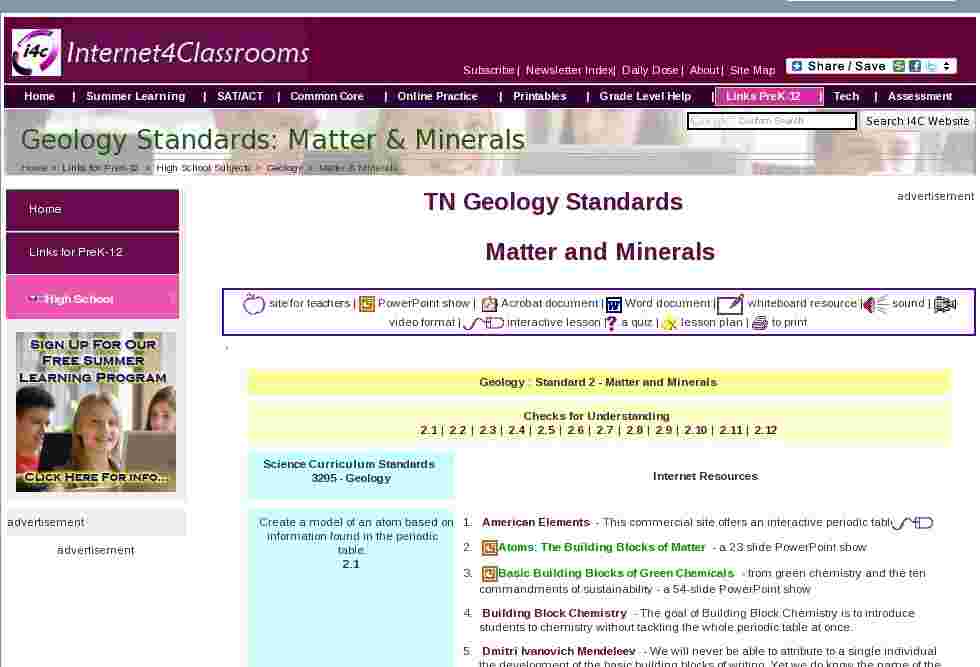TN Geology Standards
Matter and Minerals
site for teachers |
PowerPoint show |
Acrobat document |
Word document |
whiteboard resource |
sound |
video format |
interactive lesson |
a quiz |
lesson plan |
to print
Science Curriculum Standards
3205 - GeologyCreate a model of an atom based on information found in the periodic table.
2.1
- American Elements - This commercial site offers an interactive periodic table.
Atoms: The Building Blocks of Matter - a 23 slide PowerPoint show
Basic Building Blocks of Green Chemicals - from green chemistry and the ten commandments of sustainability - a 54-slide PowerPoint show
- Building Block Chemistry - The goal of Building Block Chemistry is to introduce students to chemistry without tackling the whole periodic table at once.
- Dmitri Ivanovich Mendeleev - We will never be able to attribute to a single individual the development of the basic building blocks of writing. Yet we do know the name of the man who devised the method of classifying the basic building blocks of matter. Dmitri Ivanovich Mendeleev!
- Flash version of the table - Move your cursor over an elements for information.
- It's Elemental - Element Math Game - answer the question that the computer asks about the number of protons, neutrons, electrons or nucleons (particles in the nucleus) that an atom of that element contains. Press the 'Check my answer' button after you have entered your answer.
Parts of an Atom and Organization of The Periodic Table - a 29 slide PowerPoint show plus nine assessment slides at the end of the show
- Periodic Table of the Elements
- Periodic Table from ChemiCool
Periodic Table - This common chemistry tool is presented as a PowerPoint show with web links to pages about each element. Invisible buttons are used on slide 2. (There are 109 invisible buttons on one slide.) Download the show and take a look!
The Periodic Table and the Elements - a 19 slide PowerPoint show
Periodic Tendencies -
- Proton Don - a FunBrain game using a periodic table that contains the elements' symbols and their periodic numbers.
- Quiz on "The Structure and Groups of the Periodic Table"
- Visual Elements offers two versions. One requires the Shockwave plug-in Flash, and the other is an HTML document
- Classification of Matter - Identify which of the substances are pure substance or a mixture
- Compounds - includes tables of examples
- Element, Compound, and Mixture - a quiz from Quia
- Element, Compound, or Mixture - a ten question quiz

- Element Formulas - From the name of an element, determine the formula (if different from the symbol)
- Element or Compound - from the name of a chemical, determine whether it is an element or compound
Element or Compound - a 58 slide PowerPoint show with good images, questions, and assignments
- Is a Diamond Element or Compound - answer to the question from Ask A Scientist
- Network or Molecular Compounds - from the name of a compound, determine whether it is network or molecular
- Crystallography and Mineral Crystal Systems - a nine part explanation that's very complete.
- Gem and Mineral collection from the Smithsonian. Almost four dozen of the most beautiful naturally occurring minerals or polished gemstones from the collection.
- Gemstone Gallery offers good information about the mineral to accompany excellent pictures.
- Gemstone Index - an alphabetical listing, you can also search by color or by birthstone
- Mindat.org is the largest mineral database on the internet. Currently there are 11,185 different minerals, varieties and synonyms listed, and information on 159,326 mineral occurrences worldwide, from 29,868 different sites.
- The Mineral Gallery - A service of Amethyst Galleries,Inc., "The First Internet Rock Shop"
- TheImage.com offers their own Mineral Gallery with good information about the mineral to accompany the picture.
- Mineralogy Database in HTML Format. This mineral database contains more than 5,000 pages of mineral data. There are 3,968 individual mineral species descriptions with links
- Minerals - See a photograph and get a description of physical characteristics of the mineral.
- Physical Characteristics of Minerals - an explanation of the physical properties most useful for mineral identification
- Rock and Mineral Database - from the Natural History Museum of London
- Crystallography and Mineral Crystal Systems - a nine part explanation that's very complete.

Search Internet4Classrooms
 Custom Search
Custom Search
- Site Map |
- About Us |
- Teacher Training |
- Make Internet4Classrooms.com your home page. |
- Copyright © 2000-2024 Internet4Classrooms, LLC All rights reserved.
Use of this Web site constitutes acceptance of our Terms of Service and Privacy Policy.
1744510355139094 US 2 desktop not tablet not iPad device-width